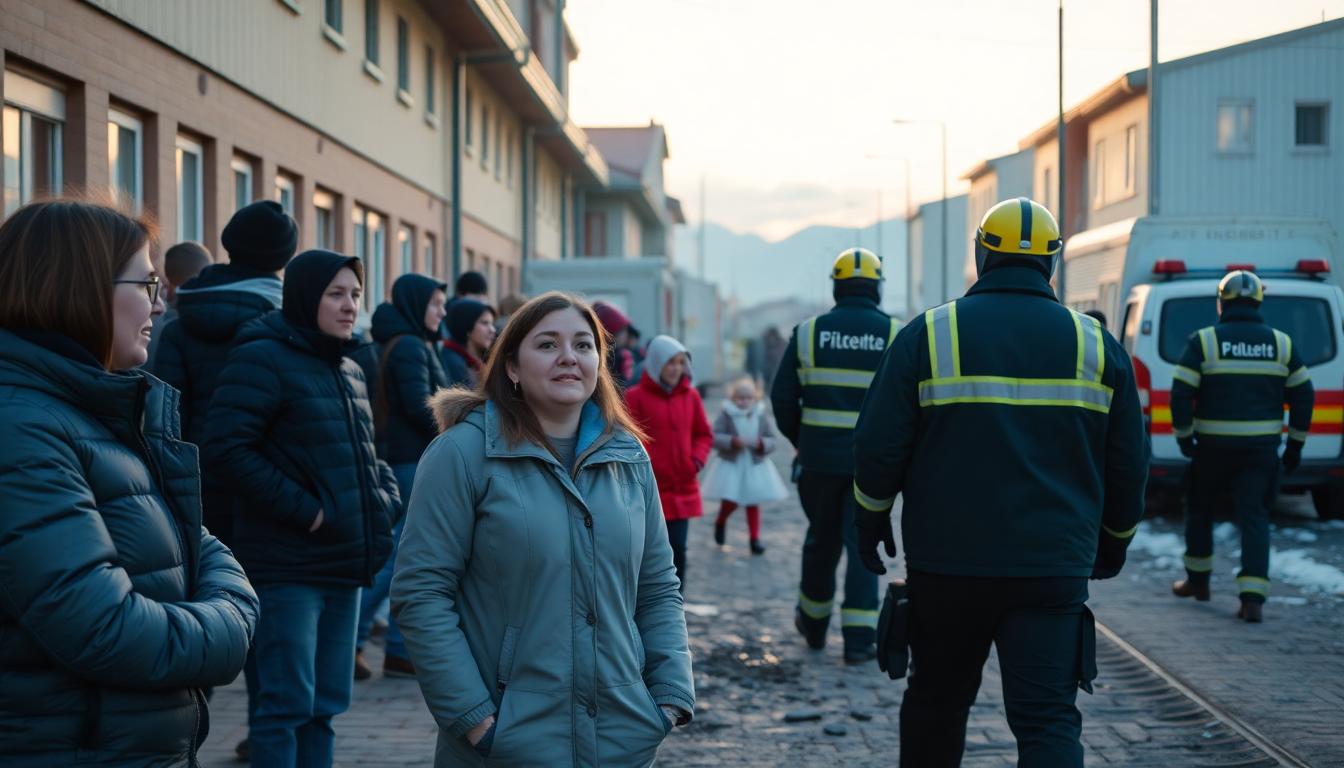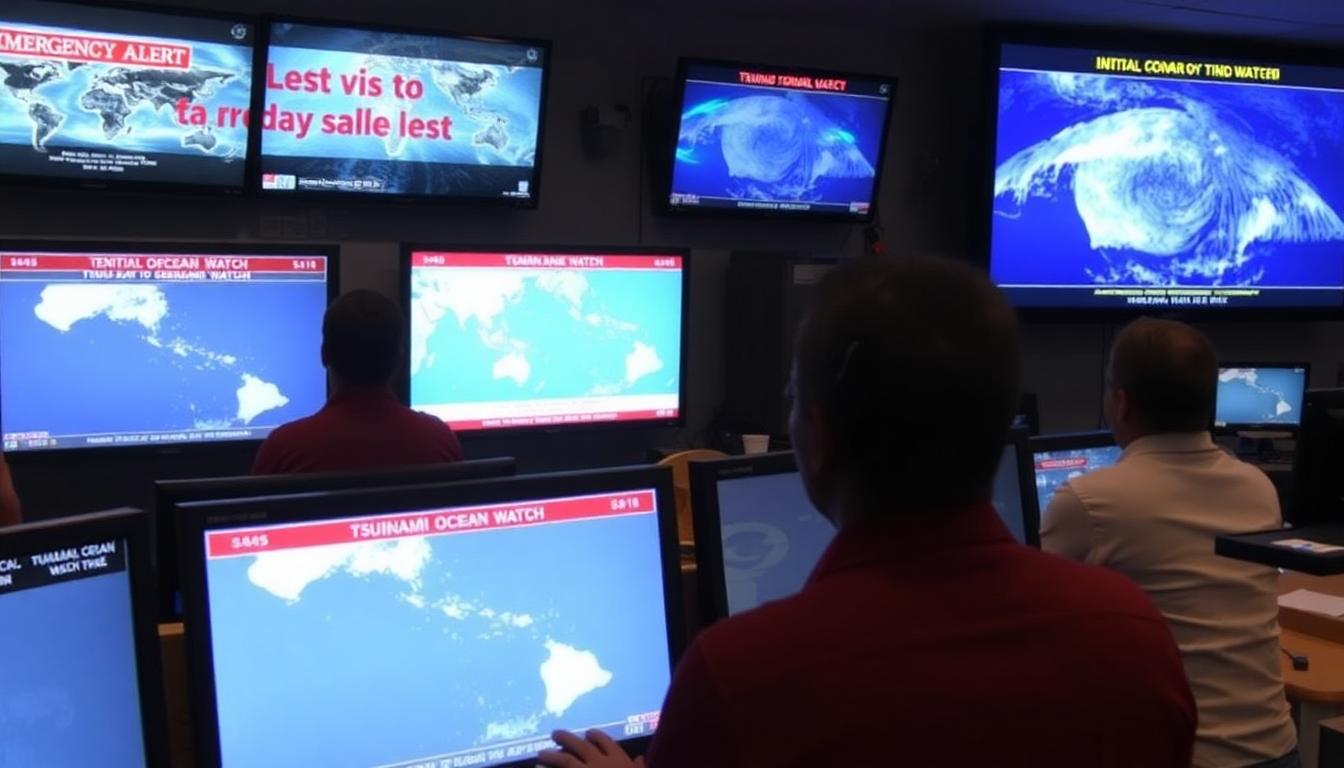Introduction
On July 20, 2025, millions across two continents braced for nature’s fury. In Russia, a massive earthquake off the coast of Kamchatka shook homes, startled families from sleep, and sent shudders down old, volcanic mountains. Far across the Pacific, in Hawaii, ordinary people’s phones shook with alerts. A tsunami watch was on. For one long night, science, memory, and community stood between hope and disaster.
This is the human story behind the headlines and warnings—a story of geography, history, urgent science, and the quiet courage of people from Kamchatka to Honolulu.
I. The Earthquake Strikes
In the early hours before dawn, the earth beneath the Pacific Ocean off Kamchatka, Russia, split with a thunder that only nature can summon. Seismic monitors registered a deep, sharp tremble—a powerful 7.4 magnitude undersea earthquake. This was not a small jolt. Within seconds, shockwaves traveled through the crust, through the ocean, and into people’s lives.
Kamchatka is no stranger to powerful quakes. The peninsula sits where the giant Pacific and North American tectonic plates grind together, a place where the earth’s might can surprise even the most prepared. For generations, towns like Petropavlovsk-Kamchatsky have lived with the small shakes that barely rattle a cup and the rare monsters that topple buildings.
On this Saturday morning, people felt more than a gentle tremor. Windows rattled, dishes shivered off shelves; some buildings shuddered like leaves. Families grabbed children, cell phones, and flashlights. In the seconds that followed, fear and confusion turned into action—checking on neighbors, making sure old relatives were awake and safe, calling loved ones.

First responders moved quickly. They patrolled the streets, checked schools, and scanned apartment blocks for cracks or broken water lines. Emergency services calmed panicked families, reassured those waiting outside, and coordinated with Moscow and local authorities.
II. The Wave That Might Come: Tsunami Fears
Within minutes of the quake, scientists had a new worry: could this undersea movement send a wall of water racing across the ocean? In Kamchatka, memories linger of the great quakes of the past—like the tsunami of 1952 that devastated towns and later reached Hawaii.
Russia’s meteorological agencies sent out fast warnings. “Evacuate low-lying areas, move to higher ground,” they advised, though initial readings suggested only small waves—no giant, city-crushing surge.
Meanwhile, across the blue Pacific, thousands of miles away and hours behind, another group watched their screens closely: the staff of the Pacific Tsunami Warning Center.
In Hawaii, it was Friday evening. Families were finishing dinner, tourists watched the sun dip below the surf, teens scrolled through their phones. Then, suddenly, the alert hit: “Tsunami Watch issued for Hawaii.” The time on the screen: “Earliest possible arrival, 2:43 a.m.”
People on the islands know these signals well. Schools practice drills, sirens sometimes wail during tests. But real warnings feel different. Some residents began gathering emergency supplies—water, food, extra gas. Others called family on other islands. Hoteliers prepared to move guests to higher floors. Memories echoed through households: the 2011 tsunami from Japan, the 1960 tragedy from Chile, and the legendary waves of the past.

Scientists and meteorologists in darkened rooms pored over charts and ocean gauges. Computers tracked every inch of the Pacific, measuring any blip that could hint at rising waves. Outside, the hum of a nervous community pulsed below the surface.
III. A Night of Waiting
In Hawaii, the minutes crept by. People kept their radios tuned, peered at news websites, and huddled with friends and strangers. Would the ocean stay calm, or would the night end in evacuation, destruction, or worse?
For hours, uncertainty ruled. The Pacific Tsunami Warning Center’s dashboard flickered with changing numbers—first, early models showed only a small risk, but it was still uncertain. In Moscow and Petropavlovsk-Kamchatsky, scientists coordinated with their American and Japanese colleagues.
On the coasts of Kamchatka, many chose not to sleep. The Russian Ministry of Emergency Situations urged people to stay safe, avoid the beaches, and not try to film or approach any waves. Social media spread both rumors and comfort—some worried, some reassured, many simply waited in solidarity.
As the hours ticked on, those on Hawaii and Kamchatka began to hope. The earth had shaken, but was the worst over?
IV. Relief and Reflection
Finally, just before dawn in Hawaii, the news came: the tsunami watch was canceled. No threatening waves. No damage reported. The ocean stayed quiet except for its natural, peaceful rhythm.
In Russia, only minor waves brushed the shore. Emergency crews breathed a collective sigh of relief. No mass evacuations, no major injuries, no disaster. By morning, people returned home, swept up broken glass, fixed picture frames, and talked to each other about how close they’d come to catastrophe.
On the beaches of Oahu, Maui, and the Big Island, visitors and locals gathered for another sunrise. They stared out at the gentle swell, hugged family and friends, and gave thanks for another ordinary, beautiful day.

V. Lessons From the Tremors
Even when disaster does not strike, these moments test our communities and systems. For scientists, the event was a reminder of why real-time monitoring and international data-sharing matter so much. The Kamchatka Peninsula is one of the world’s most active seismic zones, and every big quake is a lesson in prediction, risk, and rapid reaction.
For officials and first responders, the quake showed the value of readiness—fast alerts, good communication, and calm under pressure. It also reminded both residents and tourists everywhere to take preparedness seriously.
Most of all, these hours taught us about empathy and togetherness. On both sides of the Pacific, people came together to protect, inform, and wait together. In Kamchatka, community ties deepened over shared coffee and quiet nerves. In Hawaii, families comforted each other, grateful for safety.
Some social media users used the night as a time to reconnect with local history—teaching new generations the stories of past tsunamis, the heroes who saved lives, and the importance of respecting nature’s power.
VI. Looking Ahead
No one can predict when the next quake or wave will come. But for those living in places like Kamchatka or Hawaii, readiness is a way of life. Earthquakes and tsunamis are unstoppable events—but resilience and community spirit can shape how people weather the storm.
Officials are using 2025’s near-miss as a chance to update local emergency plans, install more sensors, and boost public awareness campaigns. People across the Pacific are sharing survival kits, posting checklists online, and telling younger generations what to do when the sirens sound.
Nature gave a warning—echoing the past, but without tragedy this time. The world listened and learned, and, at least for now, life goes on.
VII. Key Events Timeline
- July 20, 2025 Pre-dawn, Russia: Magnitude 7.4 earthquake strikes off Kamchatka. Houses shake, first responders mobilize.
- Minutes later: Russian and international agencies issue tsunami warnings; small waves expected.
- Morning, Hawaii time: USGS and the Pacific Tsunami Warning Center issue tsunami watch for Hawaii.
- All night: Russian, US, and Japanese teams analyze data; Hawaii prepares for possible waves.
- Just before dawn (Hawaii): Tsunami watch is canceled; no destructive waves arrive.
- Later July 20: Kamchatka communities check for damage, Hawaii returns to normal.
VIII. Human Voices
- Anya S., Kamchatka resident: “My grandmother told stories about the old tsunami. We never take these warnings lightly. That night, we braced with our coats and cats ready, praying the worst would pass.”
- David L., Maui lifeguard: “You work on the beach long enough, you know the ocean can change fast. I was ready for an early shift if we needed to help. Relieved I just had to watch the sunrise.”
- Elena V., Russian emergency worker: “Our drills paid off. Everyone knew where to go, what radio station to tune in. We’re grateful tonight was only a scare.”
IX. Science at Work
The quick, accurate response was only possible because of decades of teamwork and investment. Real-time earthquake sensors, satellite data, underwater microphones, and automated warning systems worked together across borders.
The Kamchatka region’s history—seven magnitude 8.3+ quakes in the last century, including one that caused 9-meter waves in Hawaii—makes this a vital focus for scientists. Each warning and watch makes the community safer the next time.
X. Conclusion: A Quiet Dawn
Nature’s fury is unstoppable, but the quiet heroism of ordinary people turns a near disaster into a story of hope. The July 2025 Russia-Hawaii quake and tsunami watch—the hours of trembling, warning, waiting, and relief—remind us how strong, resourceful, and united far-flung communities can be.
For the families of Kamchatka, the civil defense planners of Hawaii, and everyone who stared at the sea—or their phones—through a tense night, the earth’s tremor ended with gratitude, not heartbreak.
To contact us click Here .

